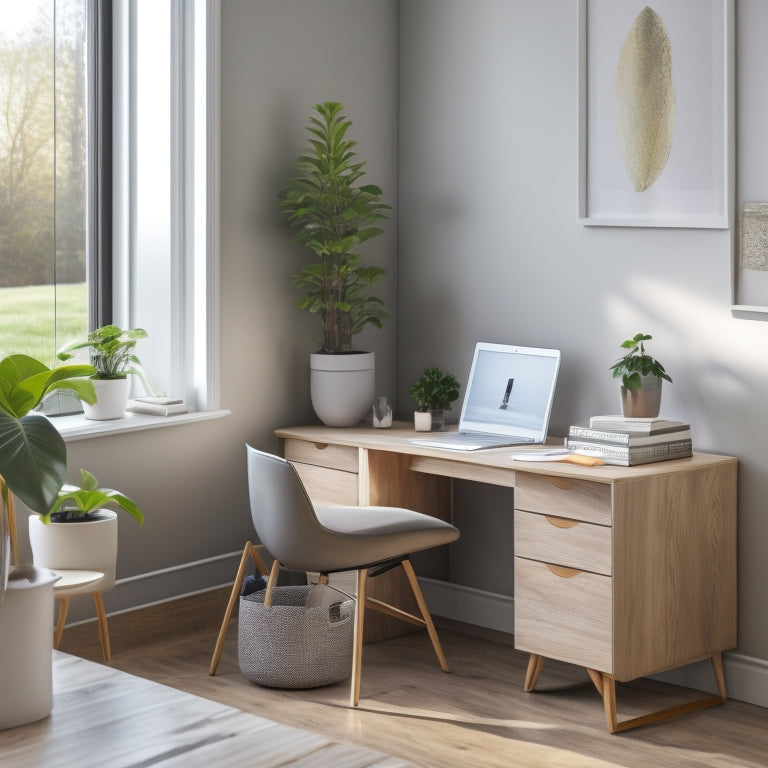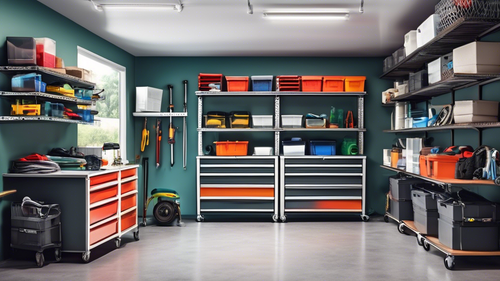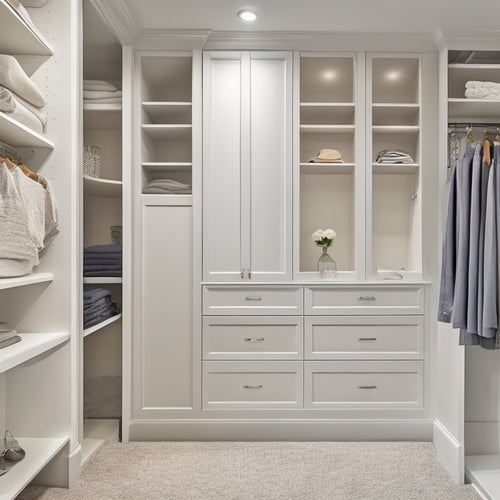
What Keeps Your Home Office Clutter-Free?
Share
You maintain a clutter-free home office by implementing a combination of essential decluttering tools, functional workspace design, and regular maintenance habits that prevent clutter from building up in the first place. This includes labeling systems, minimalistic approaches, and organizational tools to maximize space. You'll also want to create a functional workspace with optimized desk space, efficient storage solutions, and ergonomic accessories. By establishing regular cleaning routines, managing paper and digital files wisely, and scheduling regular maintenance, you'll be able to keep your home office clutter-free and productive. Get ready to take your organization to the next level.
Key Takeaways
- Implementing a labeling system and minimalistic approach helps categorize and prioritize tasks, preventing future clutter buildup.
- Establishing cleaning routines and time management techniques maintains organization and enhances productivity.
- Efficient storage solutions, such as file organizers and shelves, maximize space and keep essential items within easy reach.
- Regularly sorting and purging papers, and utilizing a paper organization system, prevents paper clutter from accumulating.
- Scheduling regular maintenance, including weekly tidying and monthly workspace reviews, ensures clutter-free home office space.
Essential Decluttering Tools Needed
With a cluttered home office staring you down, it's easy to feel overwhelmed, but having the right tools at your fingertips can make all the difference. You need a solid foundation of decluttering habits, starting with labeling systems to categorize and prioritize tasks.
A minimalistic approach will help you avoid clutter buildup in the future. By implementing a logical filing system Streamlining Digital Systems and maintaining a clutter-free workspace, you'll be able to focus on tasks more efficiently.
Invest in organizational tools like file organizers, desk trays, and shelves to maximize space management. Establish cleaning routines to maintain your newly organized space.
To enhance productivity, incorporate time management techniques, digital organization, and focus techniques. By equipping yourself with these essential tools, you'll be better equipped to tackle your cluttered home office and stay on top of your work.
Creating a Functional Workspace
You'll want to optimize your desk space by designating specific areas for tasks, such as a laptop station, a writing surface, and a spot for frequently used supplies.
Next, look for efficient storage solutions that keep essential items within easy reach, like a desktop organizer or a file cabinet with labeled drawers.
Optimize Your Desk Space
A cluttered desk can be a significant productivity killer, making it challenging to focus on the task at hand. To optimize your desk space, start by selecting the right desk accessories that promote an ergonomic setup. This includes a comfortable keyboard tray, a monitor stand, and a supportive chair.
| Accessory | Purpose | Benefits |
|---|---|---|
| Keyboard Tray | Raise keyboard to comfortable height | Reduces strain on wrists and hands |
| Monitor Riser | Position monitor at eye level | Improves posture and reduces neck strain |
| Task Lamp | Provides focused lighting | Enhances visibility and reduces eye strain |
Efficient Storage Solutions
Behind every organized workspace lies a well-thought-out storage strategy.
You'll want to maximize your space by incorporating efficient storage solutions. Consider investing in vertical storage units, such as shelves or bookcases, to keep frequently used items within easy reach.
Multifunctional furniture, like a desk with built-in storage or a file cabinet with a workspace, can also help streamline your workspace. Label each storage compartment to maintain organization and make it easy to find what you need.
Managing Paper Clutter Effectively
You're likely no stranger to the frustration of sifting through piles of paperwork, only to find what you need buried beneath a mountain of unnecessary documents.
To take control of your paper clutter, you'll need to sort and purge papers, getting rid of anything unnecessary or outdated.
Sort and Purge Papers
Since paper clutter tends to accumulate rapidly, tackling it regularly is essential to maintaining a clutter-free home office.
You'll need to develop a system for paper organization and document retention. Start by gathering all papers from your workspace and sorting them into categories, such as bills to pay, documents to file, and papers to recycle.
Be ruthless – get rid of anything unnecessary or outdated. Consider scanning important documents and saving them digitally to free up physical storage space.
Set a schedule to review and purge papers regularly, ensuring your paper organization system remains effective. This process will help you stay on top of paper clutter and maintain a clutter-free home office.
Designate Filing Zones
Now that you've sorted and purged your papers, it's time to create a system for managing the papers you need to keep.
Designate filing zones to maintain control over your paperwork. This involves categorizing files into specific groups, such as "to-file," "to-recycle," and "to-shred."
-
Set up a file categorization system that makes sense for your work, such as categorizing by project, client, or date.
-
Establish a document retention policy to guarantee you're keeping only what's necessary.
-
Assign a specific location for each filing zone, like a file cabinet or a designated shelf, to maintain organization and ease of access.
Organizing Digital Files Wisely
How much time do you waste searching for digital files that are scattered all over your computer or cloud storage? Implementing a solid digital file management system can save you hours.
Start by setting up cloud storage options like Google Drive or Dropbox, and establish document naming conventions to make files easily identifiable.
Develop a backup strategy to guarantee your files are protected in case of a crash or cyberattack.
Organize your software by categorizing files into folders and subfolders, and employ digital decluttering techniques to eliminate unnecessary documents.
Finally, implement email organization strategies, such as labeling and filtering, to keep your inbox tidy.
Scheduling Regular Maintenance
Every few weeks, dust and clutter can creep back into your newly organized home office, undoing all your hard work.
To prevent this, it's crucial to establish maintenance habits that keep your space tidy and organized.
Create a cleaning schedule that works for you. This might include:
- Setting aside 30 minutes each week to tidy up your workspace
- Scheduling a deeper clean every two weeks to tackle dusting and disinfecting
- Allocating one hour each month to review your organizational systems and make adjustments as needed
Storage Solutions for Success
With your newly established maintenance habits in place, it's time to focus on the next essential element of a clutter-free home office: strategic storage solutions.
You'll want to contemplate shelving options that maximize vertical storage, keeping frequently used items within easy reach. Container choices should be functional and visually appealing, with drawer dividers to keep contents organized.
Implement a labeling system to quickly identify what's inside. Multifunctional furniture with a minimalist design will help you make the most of your space.
Prioritize space-saving solutions that keep your office tidy and efficient. By incorporating these storage solutions, you'll be able to maintain your clutter-free home office with ease.
Frequently Asked Questions
How Do I Stay Motivated to Declutter My Home Office Regularly?
You're the conductor of your productivity orchestra, and decluttering is the harmonious melody. To stay motivated, set achievable goals, reward yourself, and implement decluttering strategies like the Pomodoro Technique and motivation techniques like visual cues to keep you on track.
Can I Repurpose Old Furniture for My Home Office Organization?
You can breathe new life into old furniture by upcycling it into creative storage solutions for your home office, such as turning an old dresser into a file cabinet or a vintage ladder into a bookshelf.
How Often Should I Back up My Digital Files for Safety?
Like a shipwrecked sailor clinging to a lifeline, you're wise to prioritize digital backup, setting a schedule to safeguard your files every week, or at least monthly, using reliable file storage to avoid catastrophic losses.
Can a Cluttered Home Office Affect My Mental Health Negatively?
You know a cluttered space can weigh heavily on your mind; it's proven to negatively impact mental health, hindering mental clarity and reducing productivity. By keeping your office organized, you'll experience a significant productivity increase and a clearer, more focused mind.
What Are Some Eco-Friendly Ways to Dispose of Old Office Supplies?
Are you drowning in a sea of outdated office supplies? You take control by exploring local recycling programs for responsible disposal. Then, invest in sustainable storage solutions to keep your new, eco-friendly essentials organized and within reach.
Related Posts
-

Maximize Your Garage Space: Organization Tips for Small Garages
Introduction: Prepare to transform your cramped garage into an organized haven! As a staunch advocate for creating...
-

What Makes a Custom Closet Storage System Perfect?
When it comes to creating a perfect custom closet storage system, you need a balance of form and function. You want t...
-

Best Stackable Containers for Flour Storage
When it comes to storing flour, you need stackable containers that prioritize freshness and organization. Look for ai...


